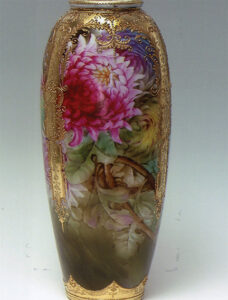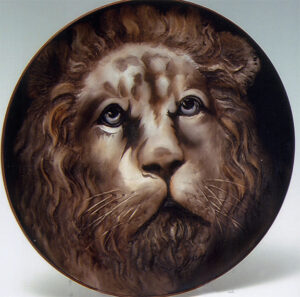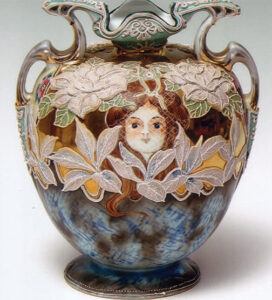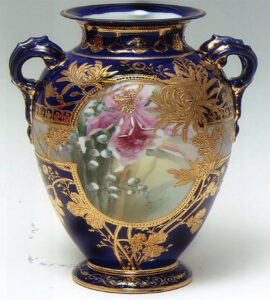 By Joan F. Van Patten
By Joan F. Van Patten Psychologists tell us we’re all collectors at heart, some to a greater degree than others to be sure, and once we start most of us find we’re trapped into this predicament for life, we become addicted! “Collectoritis” is what I’ve termed this ailment, but make no mistake; most of us are not seeking an antidote nor do we wish to be cured. Some collectors are obsessive, compulsive and cannot stop. Many are even packrats. But I think that the “hunt” is almost as desirable to most people as the actual possession of a piece. Collecting makes life exciting and perhaps it is especially enjoyable because it gives us a chance to recapture a bit of the past.
History can inspire us and evoke memories of bygone days. Our old collectibles tell us how another generation lived, their manners and customs. How often today do you see hatpin holders for sale in your mail order catalogues? Or a small daintily painted spittoon or hair receiver? These items give us an insight into how grandmother lived. They are our heritage and keys to the past. Hopefully, they will be preserved and passed down to further generations so that they too may enjoy them.
The late Victorian age seems to be a favorite era with collectors. Gaudy items abound and to the people of this era the more intricate the design, the more ornate the item, the better it was. Decoration was identified with beauty.
 Nippon porcelain was manufactured between the years of 1891 to 1921 and was in demand during the Victorian peri- od. Nippon is not the name of the china as many think but actually the name of the country where it was manufactured, Japan. Collectors will find the word Nippon in the backstamp. The McKinley Tariff Act decreed that all items being imported into the United States had to be marked with the country of origin and since Nippon was the name Japan used back then it was placed on items for export to the US. In 1921, the law was changed as the United States then felt that Nippon was a Japanese word and items should be marked with the English word of Japan.
Nippon porcelain was manufactured between the years of 1891 to 1921 and was in demand during the Victorian peri- od. Nippon is not the name of the china as many think but actually the name of the country where it was manufactured, Japan. Collectors will find the word Nippon in the backstamp. The McKinley Tariff Act decreed that all items being imported into the United States had to be marked with the country of origin and since Nippon was the name Japan used back then it was placed on items for export to the US. In 1921, the law was changed as the United States then felt that Nippon was a Japanese word and items should be marked with the English word of Japan. For over two hundred years Japan managed to remain isolated from the outside world. Then in 1853 there began a tremendous change of events. Commodore Matthew Perry landed with his ‘Black Ships’ and Japan soon found itself opened to world trade and a flood of European art was brought to its shores. The country had an overabundance of labor and as a result low wages were paid to most of the workers enabling it to export items for lower prices than those being made in other countries such as Austria or Germany. Members of families engaged in this work – from the little boy or girl to the old grandfather, whose feeble strength was utilized in some simple process of the work. These items were sold everywhere in the United States, at the five and dime store, the corner grocery store, mail order catalogs, boardwalks, fairs, carnivals and gift shops. In an old Sears catalog we find a 13 piece chocolate set selling for $1.48, salt and pepper sets for $.19 and vases for $.50; certainly reasonable prices for that time period.
 Previously, the Japanese attached little emphasis to ornamentation but in their quest for trade the Japanese began to manufacture and decorate items in styles pleasing to the Westerners. Pottery factories sprang up everywhere. Many pieces of Nippon are hand-painted and say so on the backstamp. Others can be found decorated with decalcomanias (transfer prints). There is such diversity; so many techniques were used on Nippon porcelain that it can often bewilder the advanced collector as well as the beginner. Just as soon as we think we have seen it all, up pops another intriguing design or texture.
Previously, the Japanese attached little emphasis to ornamentation but in their quest for trade the Japanese began to manufacture and decorate items in styles pleasing to the Westerners. Pottery factories sprang up everywhere. Many pieces of Nippon are hand-painted and say so on the backstamp. Others can be found decorated with decalcomanias (transfer prints). There is such diversity; so many techniques were used on Nippon porcelain that it can often bewilder the advanced collector as well as the beginner. Just as soon as we think we have seen it all, up pops another intriguing design or texture. Mention the word “Nippon” to most people and they conjure up a vision of pretty little white dishes decorated with flowers or a small scene. And right they would be, for a good deal of Nippon pieces fall into this category. What many do not know, however, is the variety of items available. There are those decorated in a Wedgwood style, some have a tapestry appearance, others are relief molded while some have tiny colorless beads applied and collectors term this technique as coralene. One can find pieces decorated in the style of Dutch Gouda wares, others may have slip trailing of clay on them which we call moriage, while some have sprigged-on ornamentation. And the diversity of items that can be found is mindboggling, anything from vases to humidors, chocolate sets to novelty wares. The list goes on and on. Whatever the West wanted, Japan happily supplied their needs.
 Research indicates that the Noritake Company in Nagoya, Japan manufactured the majority of these items and they are still in business today. They had artists in New York City draw many of the early designs used on their wares and these drawings were then sent to Japan for the artists to copy. Many of these handpainted design sheets were also given to salesmen in the United States and were shown to prospective clients. If and when any of these original salesman or design pages can be found they are generally more expensive than the item they portray.
Research indicates that the Noritake Company in Nagoya, Japan manufactured the majority of these items and they are still in business today. They had artists in New York City draw many of the early designs used on their wares and these drawings were then sent to Japan for the artists to copy. Many of these handpainted design sheets were also given to salesmen in the United States and were shown to prospective clients. If and when any of these original salesman or design pages can be found they are generally more expensive than the item they portray. Today, prices are soaring at unheard of levels. Just click on eBay and you will see items that once could have been purchased for just $20.00 to $100 twenty years ago now fetching prices in the hundreds and thousands of dollars. Nippon was definitely a ‘sleeper’ for many years but that is certainly not the case today. It has awakened with a loud cry! I see no end in sight for this spiraling rise in cost as more collectors than ever have discovered Nippon’s beauty and investment value. About 26 years ago, collectors in Japan decided that many of these pieces should go back home to Japan and a buying frenzy started to take place. There have been many exhibits at Japanese museums of Nippon porcelain and they have fueled an extraordinary interest in these wares.
A common question asked by novice collectors is, “What should I collect?” The following are my rules for collecting: (1) Buy to please yourself. Your collection should be a reflection of your own taste. (2) Study, study and study some more. Read the books; talk with other collectors and dealers. Knowledge is power. (3) Become discriminating, you do not need one of every type of item ever manufactured. Buy quality and stay away from damaged items. One good item is always better than purchasing two or three mediocre pieces. If rules 2 and 3 are too difficult to follow, go back to rule 1. If you really love an item and can afford it – go for it! But remember truly great collections require knowledge, work, discipline and patience. A large bank account can also help.
There is also a club devoted entirely to the collecting of Nippon porcelain. It is called the International Nippon Collectors Club (INCC) and has been in existence for about 39 years. The club has hundreds of members and publishes six newsletters a year and holds an annual convention each summer. Membership is a must for the serious collector. The club also has a website that collectors and dealers can view: www.nipponcollectorsclub.com.
It’s been said that the joy of collecting is like a love affair – the headiness of infatuation, the pursuit, and the rapture of conquest. Nippon collecting is all this and more; it brings joy, happiness, and excitement to the collector. But Nippon collecting is also addictive. You have been forewarned, so beware.















Follow Us